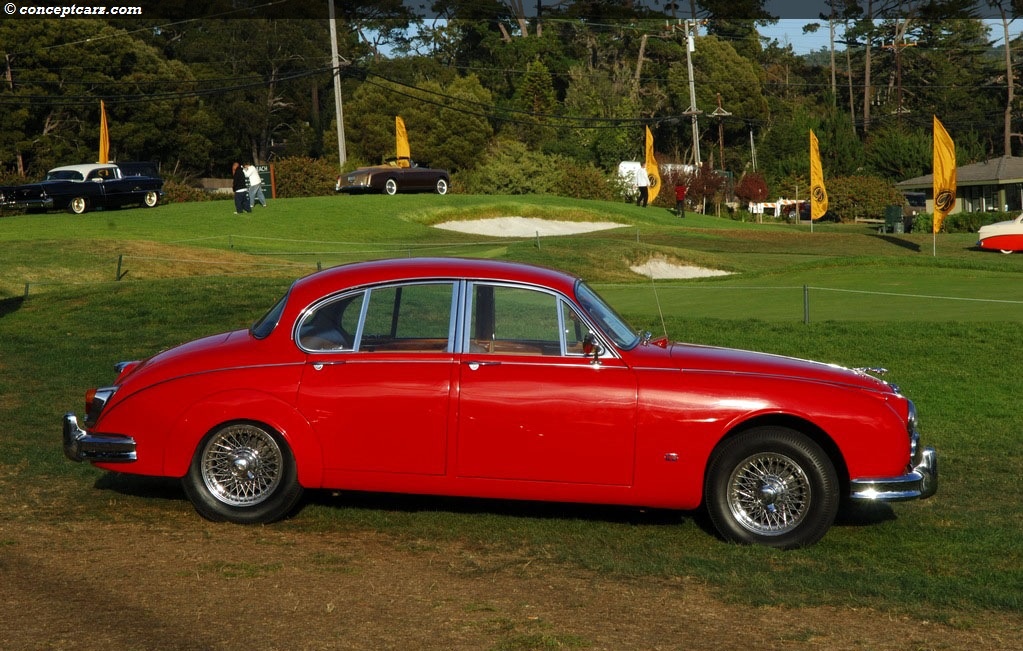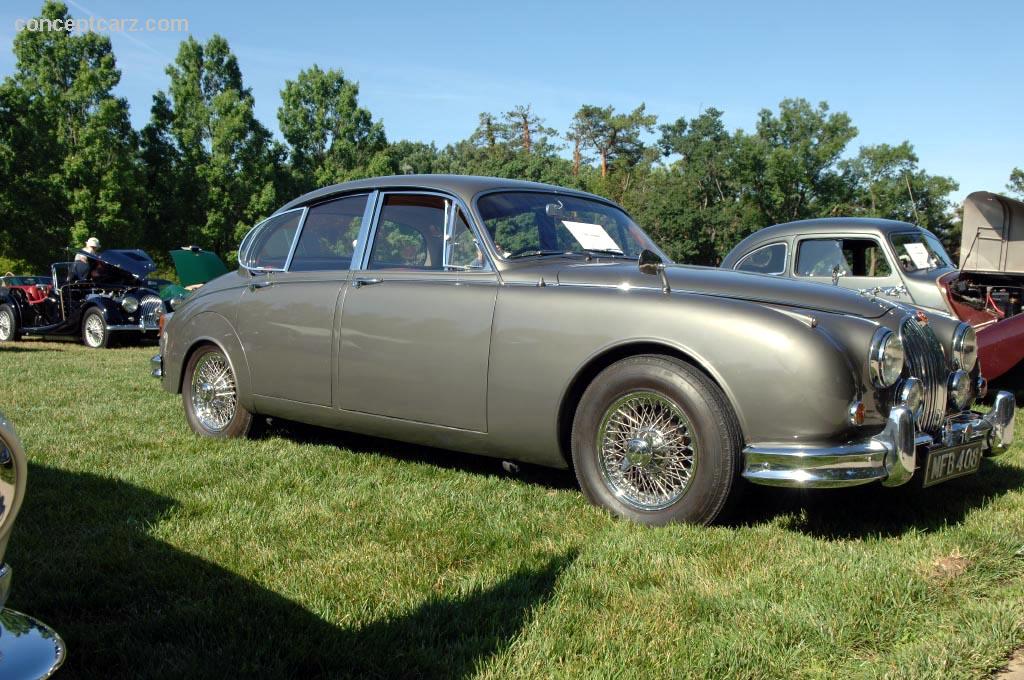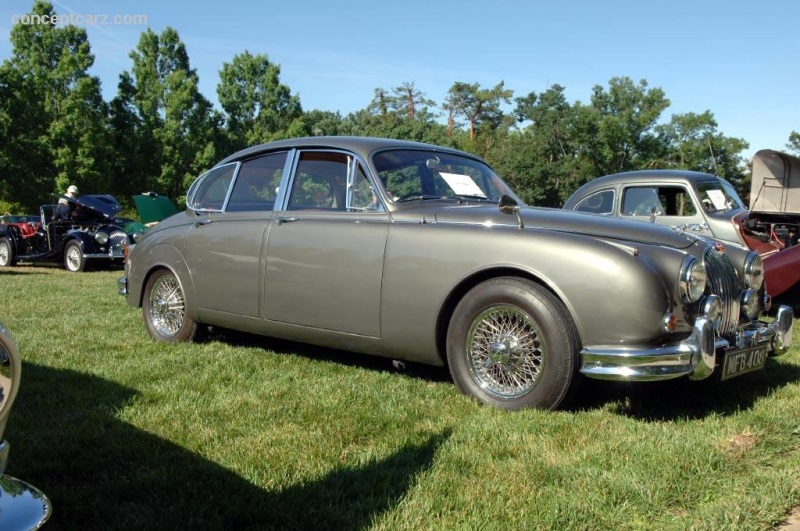1961 Jaguar MKII Navigation
Jaguar, who had been known as S.S. Cars before World War II, introduced its six-cylinder XK-120 roadster and its Mark V Saloon and Drophead Coupe in 1949. The popularity of the XK120 meant sales quickly outpaced production, with the labor-intensive aluminum skin soon shed in favor of steel coachwork. Produced through 1954, a total of 12,055 examples of the XK120 were built before being supplanted by the XK140. The Mark V remained in production through 1951 with 10,499 units built. They were the first Jaguar with hydraulic brakes, spats (fender skirts), an independent front suspension, and offered in both Right- and Left-Hand-Drive configurations. 
Sedan
Chassis #: 176963DN
View info and history
Auction entries : 1The Mark V's successor was the Mark VII built from 1951 to 1956 with 30,969 units built. It was offered as a four-door saloon and rested on the same 120-inch wheelbase platform as its predecessor, but with a more streamlined appearance with integrated headlights, longer rear overhang, and a two-piece windscreen. Unlike the prewar pushrod original powering the Mark V, the MVII employed the newly developed XK engine first used in the XK120. In 1956, the Mark VII received a new curved one-piece windscreen, rear-wheel spats, slight updates to the front grille, a curved chrome trim strip below the waistline, and a new name, the Jaguar Mark VIII. It would continue to use the 3,442cc engine of its predecessor, and production continued to 1958 with 6,227 units built. Around this time, Jaguar added a new model to the lineup dubbed the Jaguar 2.4 Litre and 3.4 Litre - retroactively renamed the Mark 1 with the arrival of the Mark 2 in October of 1959. The Mark I arrived in 1955 and remained in production through 1959 with 37,397 units built. 
Sedan
Chassis #: 176963DN
View info and history
Auction entries : 1Both the Mark I and the Mark VII shared a strong family resemblance, but also many differences. It was the first Jaguar with unitary construction of body and chassis, and its wheelbase was shorter than the Mark VII, measuring 107.5-inches. The front suspension relied on double wishbones, coil springs, an anti-roll bar, and telescopic dampers. In the back was a live axle with suspension similar to the D-Type, with inverted semi-elliptic springs cantilevered into the main body frame. A Panhard rod secured the transverse location, and the rear quarter section carried the axle, acting as trailing arms. 11.125-inch drum brakes provided the stopping power; near the close of 1957, disc brakes on all four wheels were optional. The Mark I was initially powered by a 2.4-liter short-stroke version of the twin-cam six-cylinder engine powering the XK120. From February of 1957, the Jaguar Mark VII's 3.4-liter engine also became available. When equipped with the larger engine, the Mark I received a larger front grille to cope with cooling, and a strong rear axle to handle the additional power. A four-speed manual transmission was standard and in September of 1957, a three-speed Borg-Warner automatic transmission became available with either engine. During the production lifespan of the Mark I, Jaguar produced 17,405 with the 2.4-liter engine and 17,405 with the 3.4-liter unit. The Jaguar Mark II
The Jaguar Mark II (MK2, Mark 2, Mark Two) enjoyed a lengthy production lifespan from 1959 through 1967 with 83,976 examples built. During this time, the larger, full-size Jaguar was the Mark IX (1958–1961) and the Mark X (1961-1970). Both had a 120-inch wheelbase with the Mark X featuring integrated, unitary bodywork, an independent rear suspension, and a 3.8-liter, triple carburetor engine from the E-Type. Additionally, Jaguar introduced the S-Type in 1963 that was visually similar to the Mark II but technically more sophisticated with more luxurious accommodations. It had a 107.5-inch wheelbase, a slight 1/2-inch larger than its Mark II sibling, and the Mark X independent rear suspension. The Mark 2 used a live rear axle, along with longer rear bodywork and other styling and interior differences. The S-Type was offered with either a 3.4 or 3.8-liter XK engine with twin carburetor configuration. The triple carburetor setup was too big. The Mark II was motivated by an inline-6 cylinder engine displacing 2,483 cubic centimeters with 210 horsepower. The 3,442 cc version had 220 horsepower and the 3,781 cc version with 220 horsepower. This 3.8 XK engine was similar to the one in the 3.8 E-Type, but with curved ports compared to straight ports in the E-Type. It also had a different inlet manifold and used twin SU HD6 carburetors instead of the three on the E-Type in Europe. The 3.4-liter engine also had twin SU HD6 carbs and the 2.4-liter unit had twin Solex carburetors. Standard equipment included four-wheel disc brakes and power steering. The 3.8-liter versions came with a limited-slip differential. Overdrive or automatic transmissions were optional.The four-door mid-size luxury sedan introduced a new styling scheme with improved visibility due to an 18-percent increase in cabin glass area, slender front pillars, and a rear window that wrapped around slightly near the bottom to the enlarged side windows. The radiator grille was new, with vertical slats similar to designs used on other Jaguar models, but with a rounded, narrower design and a unique center bar. The side lamps, turn signals, and flush-mounted fog lights were also unique. It had a wider rear track, a roomy passenger compartment with large front bucket seats, folding picnic tables for rear-seat occupants, and a well-designed dashboard with the tachometer and speedometer positions in front of the driver. Ancillary gauges were in a center panel.
Sedan
Chassis #: 176963DN
View info and history
Auction entries : 1The 3.8-liter version was the most popular of the three options, with 30,141 examples built from 1959 through 1967. The second most popular option was the 3.4-liter unit with 28,666 examples built, followed by 25,173 of the 2.4-liter unit. The 240 and 340
The 3.8-liter model was discontinued around September of 1967, and that is when the Mark 2 was rebadged as the 240 and 340. The 240 was powered by the 2.4-liter engine while the 340 had the 3.4-liter unit. Production of the 240 and 340 continued through 1969 with 7,234 examples built during that time. Of those, 4,446 were the 240 and 2,788 were the 340.
by Daniel Vaughan | Apr 2022
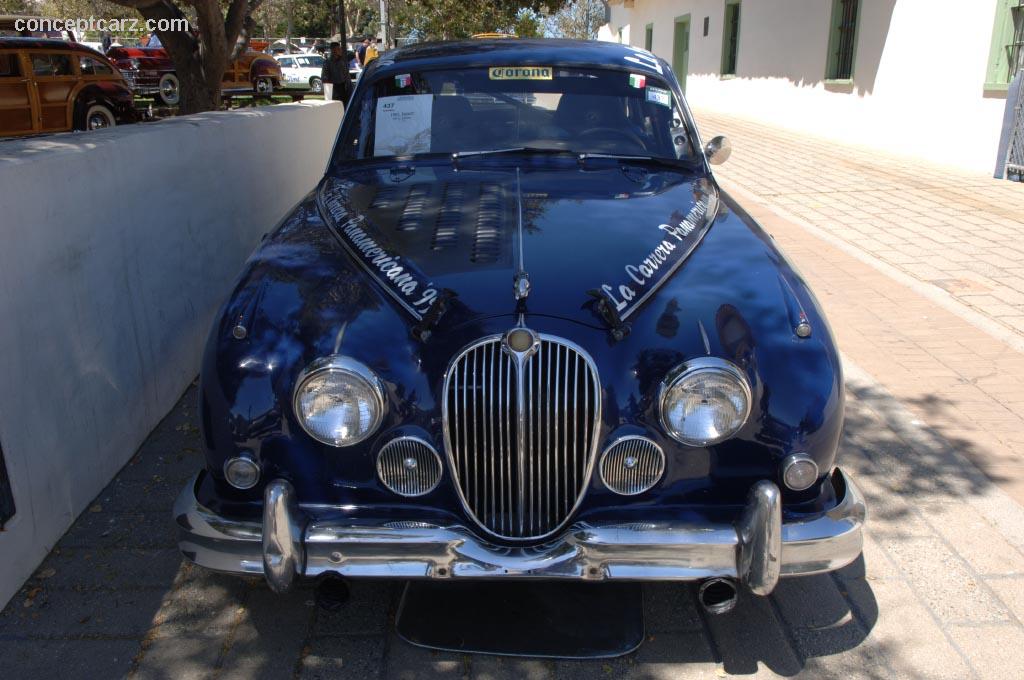
Sedan
Chassis #: 176963DN
View info and history
Auction entries : 1

Sedan
Chassis #: 176963DN
View info and history
Auction entries : 1
The Jaguar Mark II (MK2, Mark 2, Mark Two) enjoyed a lengthy production lifespan from 1959 through 1967 with 83,976 examples built. During this time, the larger, full-size Jaguar was the Mark IX (1958–1961) and the Mark X (1961-1970). Both had a 120-inch wheelbase with the Mark X featuring integrated, unitary bodywork, an independent rear suspension, and a 3.8-liter, triple carburetor engine from the E-Type. Additionally, Jaguar introduced the S-Type in 1963 that was visually similar to the Mark II but technically more sophisticated with more luxurious accommodations. It had a 107.5-inch wheelbase, a slight 1/2-inch larger than its Mark II sibling, and the Mark X independent rear suspension. The Mark 2 used a live rear axle, along with longer rear bodywork and other styling and interior differences. The S-Type was offered with either a 3.4 or 3.8-liter XK engine with twin carburetor configuration. The triple carburetor setup was too big. The Mark II was motivated by an inline-6 cylinder engine displacing 2,483 cubic centimeters with 210 horsepower. The 3,442 cc version had 220 horsepower and the 3,781 cc version with 220 horsepower. This 3.8 XK engine was similar to the one in the 3.8 E-Type, but with curved ports compared to straight ports in the E-Type. It also had a different inlet manifold and used twin SU HD6 carburetors instead of the three on the E-Type in Europe. The 3.4-liter engine also had twin SU HD6 carbs and the 2.4-liter unit had twin Solex carburetors. Standard equipment included four-wheel disc brakes and power steering. The 3.8-liter versions came with a limited-slip differential. Overdrive or automatic transmissions were optional.The four-door mid-size luxury sedan introduced a new styling scheme with improved visibility due to an 18-percent increase in cabin glass area, slender front pillars, and a rear window that wrapped around slightly near the bottom to the enlarged side windows. The radiator grille was new, with vertical slats similar to designs used on other Jaguar models, but with a rounded, narrower design and a unique center bar. The side lamps, turn signals, and flush-mounted fog lights were also unique. It had a wider rear track, a roomy passenger compartment with large front bucket seats, folding picnic tables for rear-seat occupants, and a well-designed dashboard with the tachometer and speedometer positions in front of the driver. Ancillary gauges were in a center panel.
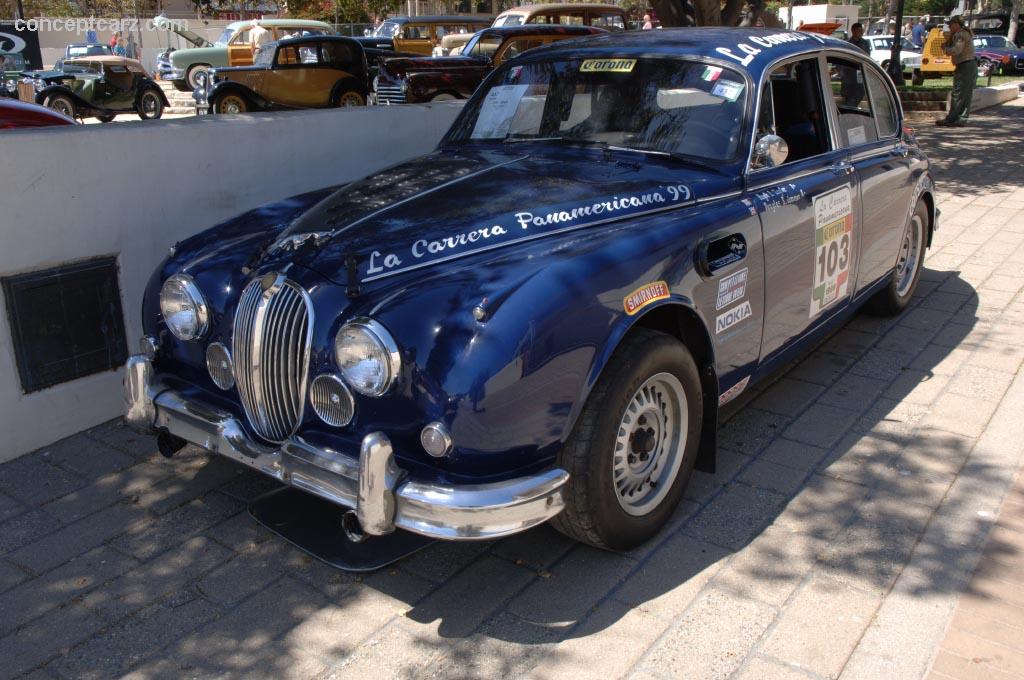
Sedan
Chassis #: 176963DN
View info and history
Auction entries : 1
The 3.8-liter model was discontinued around September of 1967, and that is when the Mark 2 was rebadged as the 240 and 340. The 240 was powered by the 2.4-liter engine while the 340 had the 3.4-liter unit. Production of the 240 and 340 continued through 1969 with 7,234 examples built during that time. Of those, 4,446 were the 240 and 2,788 were the 340.
by Daniel Vaughan | Apr 2022
Related Reading : Jaguar Mark II History
The Jaguar Mark II was introduced in October 1959 and continued in production until 1967. The MKII was built as a replacement for the 2.4 and 3.4-liter saloon, also known as the MKI. The MK II was based on the MKI, but the result was different in many ways, both aesthetically and mechanically. Improvements in the design and modern materials resulted in a reduction of overall weight. The interior....
Continue Reading >>
Continue Reading >>
Related Reading : Jaguar Mark History
The replacement for the first small unibody sedan, the 1955 Mark 1, the Mark II was an extremely elegant sedan that has been considered the most eye-catching, most compact Jaguar sedan ever. The Mark II featured a larger greenhouse, larger side and rear windows, an updated grille, fitted fog lamps, a wider rear track without the full fender skirts, and standard four-wheel disc brakes. Jaguar postwar....
Continue Reading >>
Continue Reading >>
- 1961 Jaguar MKII Menu
- Article
- Image gallery
- Valuation
- Specifications
- Profiles
- Accessories
Jaguar
Similar Automakers
Similarly Sized Vehicles
from 1961
1961 Jaguar MKII Vehicle Profiles
Recent Vehicle Additions
Performance and Specification Comparison
Price Comparison
$4,640 - $5,160
$5,599 - $5,890
$6,080
Mark II Specification Comparison by Year
Year
Production
Wheelbase
Engine
Prices
Related Automotive News

'The World's Fastest Cars' Join Gooding Christie's Amelia Island Auctions, Led by Time-Capsule RUF CTR Yellowbird, Pair of Manual AMG Hammers, Porsche 959, RUF CTR2, and Italian Supercars
The finest RUF CTR Yellowbird extant is announced for Gooding Christies Amelia Island sale, alongside two bespoke, manual-gearbox equipped AMG Hammers, a RUF CTR2 in Adriatic Blue, and ex-Brunei Royal Family Porsche 959.
Gooding Christies...

Subaru Announces Pricing on 2023 BRZ Sport Car
Second-generation lightweight handling sports car 2.4-liter SUBARU BOXER engine Subaru EyeSight Driver Assist Technology available Standard SUBARU STARLINK 8-inch Multimedia system Starting price at %2428,595Suba...

Toyota Marks 50-Millionth Corolla Sold
From A Humble Start, the Corolla Grew to Become the Worlds Best-Selling Model, and Toyota Celebrates This Milestone Cars Place in Automotive History and Customers Lives
PLANO, Texas (August 26, 2021) – This past July, Toyota sold the 50-millionth...

Subaru announces pricing on all-new 2022 BRZ
All-new, second-generation lightweight handling sports car New, more powerful 2.4-liter SUBARU BOXER engine Subaru EyeSight Driver Assist Technology now available New SUBARU STARLINK 8-inch Multimedia system Starting price a...

FROM SHELBYS TO SUPERCARS, RM SOTHEBY'S ARIZONA SALE OFFERS ICONIC COLLECTOR CARS OF EVERY ERA
Pure adrenaline 1965 Shelby 427 Competition Cobra, 1963 Shelby 289 Cobra Dragonsnake, and 1964 Shelby 289 Cobra lead recent entries for RM Sothebys Arizona Biltmore sale, January 28-29
Auction features more than 125 motor cars and offers incr...
